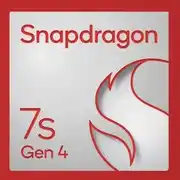Qualcomm Snapdragon 7s Gen 4

Qualcomm Snapdragon 7s Gen 4: a mid-range platform with 144 Hz displays, 5G, and a triple ISP
Snapdragon 7s Gen 4 is a mobile system-on-chip from the Snapdragon 7 series for mid-range smartphones. The platform combines a Kryo CPU in a 1+3+4 layout, an Adreno GPU, a triple 12-bit ISP, and a modern connectivity stack with 5G, Wi-Fi 6E, and Bluetooth 5.4. It emphasizes gaming features and on-device AI.
Key characteristics
-
Process: 4 nm
-
CPU: Kryo, 1+3+4 — 1 “Prime” up to 2.7 GHz; 3 “Performance” up to 2.4 GHz; 4 “Efficiency” up to 1.8 GHz
-
GPU: Adreno; supports Vulkan 1.3, OpenGL ES 3.2, OpenCL 2.0 FP
-
NPU/AI: Hexagon (INT4/INT8/INT16), Sensing Hub; local LLM/LVM scenarios
-
Memory: LPDDR5 up to 3200 MHz and LPDDR4X up to 2133 MHz, up to 16 GB
-
Storage: UFS 3.1
-
Displays: internal — WFHD+ 1300×2900 up to 144 Hz, HDR10/HDR10+, 10-bit; external — up to 4K @ 60 Hz
-
Cameras/ISP: triple 12-bit Qualcomm Spectra, photos up to 200 MP; ZSL 64 MP @ 30 FPS, 32+21 MP @ 30 FPS, or 21+21+21 MP @ 30 FPS; video up to 4K @ 30 FPS HDR, slow motion 1080p @ 120 FPS
-
Video decoder: HEVC (H.265), VP9
-
Cellular: 5G sub-6 and mmWave, SA/NSA, DSDA (5G/4G), peak downlink up to 2.9 Gbit/s
-
Wi-Fi: 6E/6/5, up to 160 MHz channels, MU-MIMO, up to 2.9 Gbit/s
-
Bluetooth: 5.4, LE Audio, Snapdragon Sound stack
-
GNSS: GPS/GLONASS/BeiDou/Galileo/QZSS/NavIC, tri-band navigation (L1/L5/L2)
-
I/O & other: USB Type-C (USB 3.1), Qualcomm Aqstic (Hi-Fi, Spatial Audio), platform security features (TEE, Type-1 Hypervisor)
-
Gaming technologies: Snapdragon Elite Gaming components — Adaptive Performance Engine 3.0, Game Super Resolution
Architecture and compute
The CPU complex uses a three-tier 1+3+4 design, distributing work among a peak-performance core, performance cores, and efficiency cores. The Adreno graphics block targets modern mobile APIs (Vulkan 1.3, OpenGL ES 3.2) and compute tasks (OpenCL 2.0 FP). The AI subsystem includes Hexagon with mixed-precision support (INT4/8/16) and an energy-efficient Sensing Hub for background audio and sensor workloads.
Displays and multimedia
The display controller supports WFHD+ 1300×2900 panels up to 144 Hz with 10-bit output and HDR10/HDR10+. External display output is supported up to 4K @ 60 Hz. Hardware video decoding covers HEVC and VP9. Recording is stated up to 4K @ 30 FPS HDR and 1080p @ 120 FPS for slow motion.
Cameras and image processing
The triple 12-bit Qualcomm Spectra ISP is designed for multi-camera setups and high resolutions. Supported features include photos up to 200 MP, ZSL capture (64 MP @ 30 FPS; 32+21 MP @ 30 FPS; 21+21+21 MP @ 30 FPS), multi-frame noise reduction (MFNR), AI Remosaic, and Video Super Resolution, as well as 10-bit formats (HEIF/HEVC) and the Rec.2020 color space.
Connectivity and wireless
The integrated modem-RF system supports 5G in sub-6 and mmWave bands, SA/NSA modes, and DSDA (simultaneous 5G/4G) with peak downlink up to 2.9 Gbit/s. The wireless block includes Wi-Fi 6E/6/5 (up to 160 MHz channels, MU-MIMO) and Bluetooth 5.4 with LE Audio and the Snapdragon Sound stack. Navigation supports major global systems with tri-band positioning.
Platform and peripherals
Declared wired connectivity includes USB Type-C based on USB 3.1. The Qualcomm Aqstic audio platform supports spatial audio with head-tracking and speaker amplification. Security features highlight a trusted execution environment (TEE) and a Type-1 hypervisor.
Who it’s for and why
-
Everyday tasks and multimedia: responsive UI, streaming with hardware decoding, and high-refresh displays.
-
Photo and video: high-detail imaging, 4K HDR recording, and efficient multi-frame processing.
-
Games and entry-level XR: modern graphics APIs and Snapdragon Elite Gaming components.
-
On-device AI: local models for speech recognition, translation, and photo/video enhancement without relying on the cloud.
Conclusion
Snapdragon 7s Gen 4 is a current mid-range SoC emphasizing 144 Hz display support, broad connectivity, and an advanced ISP. The 1+3+4 CPU on a 4 nm process, Adreno with modern APIs, and the Hexagon NPU make the platform versatile for communications, imaging, gaming, and local AI workloads.
Basic
GPU Specifications
Connectivity
Memory Specifications
Miscellaneous
- AIFF
- CAF
- MP3
- MP4
- WAV
- H.265
- VP9
Benchmarks
Compared to Other SoC
Share in social media
Or Link To Us
<a href="https://cputronic.com/index.php/soc/qualcomm-snapdragon-7s-gen-4" target="_blank">Qualcomm Snapdragon 7s Gen 4</a>